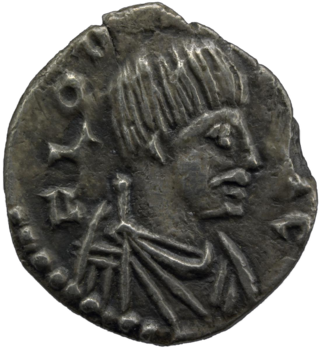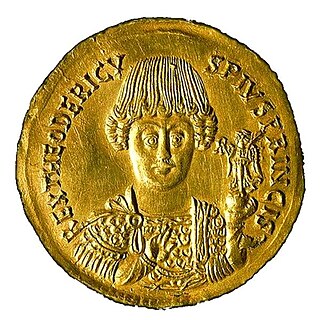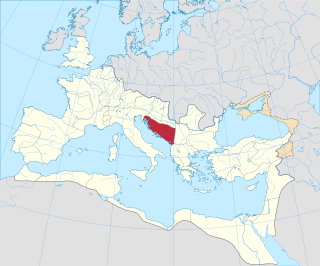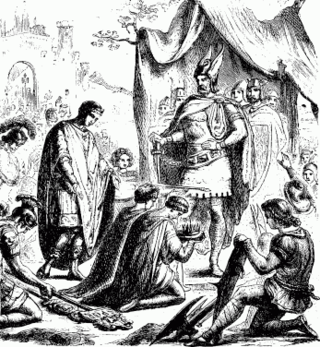
Romulus Augustus, nicknamed Augustulus, was Roman emperor of the West from 31 October 475 until 4 September 476. Romulus was placed on the imperial throne while still a minor by his father Orestes, the magister militum, for whom he served as little more than a figurehead. After a rule of ten months, the barbarian general Odoacer defeated and killed Orestes and deposed Romulus. As Odoacer did not proclaim any successor, Romulus is typically regarded as the last Western Roman emperor, his deposition marking the end of the Western Roman Empire as a political entity. The deposition of Romulus Augustulus is also sometimes used by historians to mark the transition from antiquity to the medieval period.
The 470s decade ran from January 1, 470, to December 31, 479.
The 480s decade ran from January 1, 480, to December 31, 489.

Year 475 (CDLXXV) was a common year starting on Wednesday of the Julian calendar. At the time, it was known as the Year of the Consulship of Zeno without colleague. The denomination 475 for this year has been used since the early medieval period, when the Anno Domini calendar era became the prevalent method in Europe for naming years.

Glycerius was Roman emperor of the West from 473 to 474. He served as comes domesticorum during the reign of Olybrius, until Olybrius died in November 472. After a four-month interregnum, Glycerius was proclaimed as emperor in March 473 by Gundobad, the magister militum and power behind the throne. Very few of the events of his reign are known other than that an attempted invasion of Italy by the Visigoths was repelled by local commanders, diverting them to Gaul. Glycerius also prevented an invasion by the Ostrogoths through diplomacy, including a gift of 2,000 solidi.

Odoacer, also spelled Odovacer or Odovacar, was a barbarian soldier and statesman from the Middle Danube who deposed the Western Roman child emperor Romulus Augustulus and became the ruler of Italy (476–493). Odoacer's overthrow of Romulus Augustulus is traditionally understood as marking the end of the Western Roman Empire.

Julius Nepos, or simply Nepos, ruled as Roman emperor of the West from 24 June 474 to 28 August 475. After losing power in Italy, Nepos retreated to his home province of Dalmatia, from which he continued to claim the western imperial title, with recognition from the Eastern Roman Empire, until he was murdered in 480. Though Nepos' successor in Italy, Romulus Augustulus, is traditionally deemed the last western Roman emperor, Nepos is regarded by some historians as the true last emperor of the west, being the last widely recognised holder of the position.

Zeno was Eastern Roman emperor from 474 to 475 and again from 476 to 491. His reign was plagued by domestic revolts and religious dissension, but was more successful on the foreign front. He is credited with further stabilizing the Eastern empire, while the Western Roman Empire fell following the deposition of Romulus Augustulus.

King of Italy was the title given to the ruler of the Kingdom of Italy after the fall of the Western Roman Empire. The first to take the title was Odoacer, a barbarian warlord, in the late 5th century, followed by the Ostrogothic kings up to the mid-6th century. With the Frankish conquest of Italy in the 8th century, the Carolingians assumed the title, which was maintained by subsequent Holy Roman Emperors throughout the Middle Ages. The last Emperor to claim the title was Charles V in the 16th century. During this period, the holders of the title were crowned with the Iron Crown of Lombardy.

In modern historiography, the Western Roman Empire was the western provinces of the Roman Empire, collectively, during any period in which they were administered separately from the eastern provinces by a separate, independent imperial court. Particularly during the period from AD 395 to 476, there were separate, coequal courts dividing the governance of the empire into the Western provinces and the Eastern provinces with a distinct imperial succession in the separate courts. The terms Western Roman Empire and Eastern Roman Empire were coined in modern times to describe political entities that were de facto independent; contemporary Romans did not consider the Empire to have been split into two empires but viewed it as a single polity governed by two imperial courts for administrative expediency. The Western Empire collapsed in 476, and the Western imperial court in Ravenna disappeared by AD 554, at the end of Justinian's Gothic War.

The causes and mechanisms of the fall of the Western Roman Empire are a historical theme that was introduced by historian Edward Gibbon in his 1776 book The History of the Decline and Fall of the Roman Empire. Though Gibbon was not the first to speculate on why the empire collapsed, he was the first to give a well-researched and well-referenced account of the event, and started an ongoing historiographical discussion about what caused the fall of the Western Roman Empire. The traditional date for the end of the Western Roman Empire is 476 when the last Western Roman Emperor was deposed. Many theories of causality have been explored. In 1984, Alexander Demandt enumerated 210 different theories on why Rome fell, and new theories have since emerged. Gibbon himself explored ideas of internal decline and of attacks from outside the empire.

The Ostrogothic Kingdom, officially the Kingdom of Italy, was a barbarian kingdom established by the Germanic Ostrogoths that controlled Italy and neighbouring areas between 493 and 553. Led by Theodoric the Great, the Ostrogoths killed Odoacer, a Germanic soldier and erstwhile leader of the foederati. Odoacer had previously become the de facto ruler of Italy following his deposition of Romulus Augustulus, the final emperor of the Western Roman Empire, in 476. Under Theodoric, the Ostrogothic kingdom reached its zenith, stretching from modern Southern France in the west to the modern western Serbia in the southeast. Most of the social institutions of the late Western Roman Empire were preserved during his rule. Theodoric called himself Gothorum Romanorumque rex 'King of the Goths and Romans', demonstrating his desire to be a leader for both peoples.
The Battle of the Isonzo, the Battle of the Aesontius, or the Battle of the Isontius, is the name given to the battle fought on August 28, 489, on the banks of the Isontius River, not far away from Aquileia. This river is now known as the Isonzo in Italian, and Soča in Slovene.
Flavius Armatus, also known as Harmatius, was an Eastern Roman military commander, magister militum under Emperors Leo I, Basiliscus and Zeno, and consul. He was instrumental in the rebellion of Basiliscus against Zeno, and in his subsequent fall.
Ovida or Odiva was a late Western Roman general and warlord of likely Gothic origin and the last Roman ruler of Dalmatia. Ovida initially served Julius Nepos, ruler of Roman Dalmatia and later western Roman emperor in Italy from 474 to 475. After being usurped in 475, Nepos continued to claim the imperial title in exile in Dalmatia, supported by the Eastern Roman Empire, but he was murdered by Ovida and another general, Viator, in 480. Upon his death, Ovida became the ruler of Dalmatia, a position he held until he was defeated and killed by Odoacer, the first barbarian King of Italy, in 481 or 482.

Dalmatia was a Roman province. Its name is derived from the name of an Illyrian tribe called the Dalmatae, which lived in the central area of the eastern coast of the Adriatic Sea. It encompassed the northern part of present-day Albania, much of Croatia, Bosnia and Herzegovina, Montenegro, and Serbia, thus covering an area significantly larger than the current Croatian and Montenegrin region of Dalmatia. Originally this region was called Illyria or Illyricum.

The Battle of Ravenna, capital of the Western Roman Empire, between the Heruli under their King Odoacer and the remnants of the Western Roman army in Roman Italy occurred in early September 476, and represented a culminating event in the ongoing fall of the Western Roman Empire. The Western Roman Empire had been in relative decline since the beginning of the barbarian invasions and Rome, the symbolical heart and largest city of the Western Empire, was sacked in 410 by the Visigoths and in 455 by the Vandals. By 476 the Roman emperor was little more than a puppet, having very little de facto control of any territory outside of Italy. The last Roman emperor, Romulus Augustulus, was not recognized as a legitimate ruler outside of Italy; the Eastern Roman Empire recognized Julius Nepos as the true Western Roman Emperor.

Odoacer's deposition of Romulus Augustus, occurring in 476 AD, was a coup that marked the end of the reign of the Western Roman Emperor last approved by the Western Roman Senate and the creation of the Kingdom of Italy through Odoacer's decision to adopt the title of Dux/Rex Italiae(Duke/King of Italy), although Julius Nepos exercised control over Dalmatia until 480.

The Eastern Roman Empire was ruled by the House of Leo from AD 457, the accession of Leo I, to 518, the death of Anastasius I. The rule of the Leonid dynasty coincided with the rapid decline, collapse and eventual fall of the Western Roman Empire. Following the end of the Western Empire, Emperor Zeno abolished the position of Western Roman Emperor and declared himself the sole Roman Emperor. The Eastern Roman Empire would come to last for several more centuries, and subsequent dynasties would invest large amounts of resources in attempts to retake the western provinces.
The Battle of Ravenna was fought between supporters of Orestes and supporters of Julius Nepos for control of the Western Roman Empire. In prelude to the battle, Orestes had been ordered to raise a large army to confront tribal rulers in Gaul. Instead he led his force against emperor Julius Nepos in the capital Ravenna. Nepos was defeated and deposed, but managed to flee to Dalmatia. Orestes in turn enthroned his son Romulus Augustulus as Roman emperor. He was in turn overthrown by Odoacer in September 476 following the Roman defeat at Pavia.














